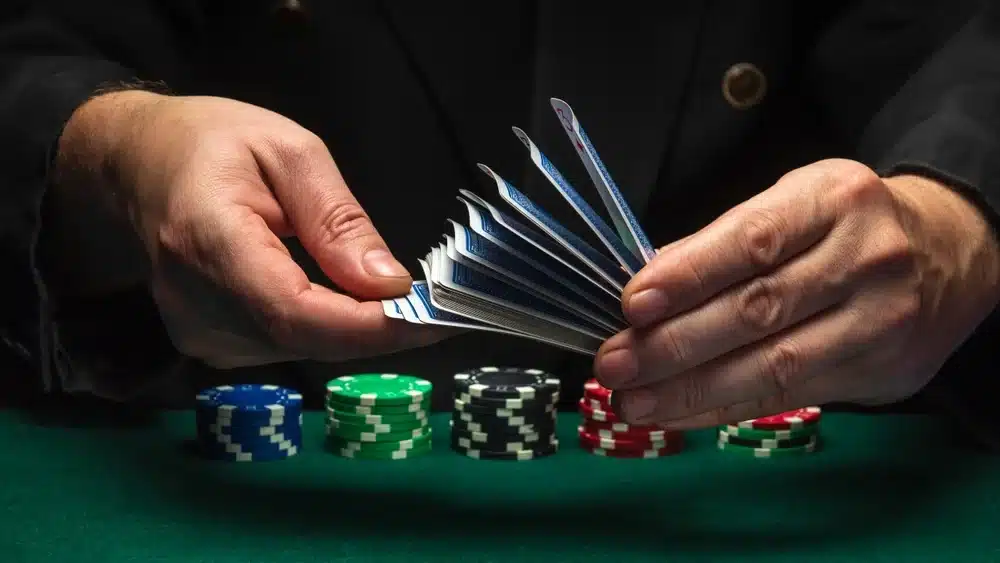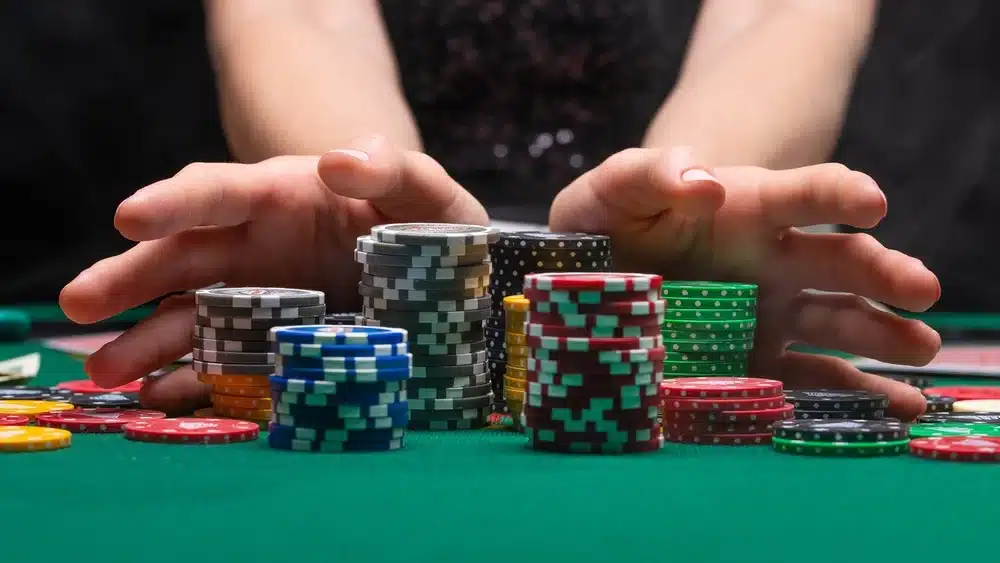Double Kokomo method: A smart roulette strategy to manage risk and win more Looking for a progressive roulette strategy with a bit more stability? The Double Kokomo method takes the classic Kokomo system and doubles our coverage by betting on two spots instead of one. This spreads your risk, smooths out losses, and slightly raises […]
Check-raise strategy explained: How, when, and why you should use it
In poker, certain moves can completely shift the flow of a game, surprising your opponents and keeping your strategy unpredictable. One of these plays is known as the ‘check-raise.’ Whenever it’s used, it adds an extra layer of excitement and pressure at the table. It’s a tactic used by both beginners finding their footing and seasoned players looking to stay one step ahead.
When used at the right moment, it can change how others see your hand, shake up the betting, and even turn a weak-looking position into a powerful one. Read about it in this guide and discover how it can turn the tide of your game at Bitcasino.
What is a check-raise?
In poker games, the check-raise is one of those clever tricks that can throw your opponents off. It starts simple: you check during your turn, making it seem like you’re unsure or playing it safe. Once someone else bets, you suddenly raise.
That unexpected move can change everything and put a lot of pressure on the table. There are more ways to improve your poker game, but catching them by surprise with the check-raise will give them a hard time.
This tactic is often used to trap other players and push them into a corner. By checking first, you might encourage someone to bet, thinking you have nothing or have a bad hand. When you raise right after, it puts pressure on them and can scare them into folding or get them to build the pot even more, which is good, especially if you’re holding a strong hand.
What is the purpose of a poker check-raise?

The purpose of the check-raise strategy is simple: it's to bluff your opponents. Have an in-depth look at how it can be used and its other purposes:
Build the pot with a strong hand
One of the main reasons to use a check-raise is when you’re holding a strong hand and want to get more money into the pot. Instead of betting straight away and possibly scaring your opponent off, you check to appear weak, which often encourages them to bet. Then, when you raise after their bet, the pot grows quickly.
It’s a clever way to get more value from players who might have folded if you made it clear that you have a very strong hand from the start. This tactic also helps protect your hand by making it expensive for opponents to stay in, especially if they are chasing a draw.
Bluff or semi‑bluff to push opponents out
Check-raises aren't only for good hands but also a strong tool when you're bluffing or semi-bluffing. If you check, it might invite a bet from an opponent who thinks you’re weak. However, once you raise, it suddenly looks like you’ve been holding a good hand, like a royal flush, all this time. This unexpected move can force your opponent to fold even if they have the better hand.
It’s also common to do this when you’re on a strong draw, meaning that you might not have the best hand yet, but you have good chances of improving it in the next few moves. This is called a semi-bluff. Either they fold and you win right away, or they call and you still have outs to win later. Mixing in check-raises as bluffs helps balance your playstyle, keeping your opponents guessing.
Changing the table dynamics
The check-raise can do more than just win a hand since it can also change how people play against you. When opponents see that you’re willing to check-raise with both strong hands and bluffs, it makes them unsure how to react whenever you do it again. Your play becomes unpredictable, and people will be confused about whether to risk their bets against you, which is something you want in a poker game.
This move also changes the table dynamics. From looking passive to suddenly being the aggressive one, this will throw off your opponent’s plan or strategy that they have built according to what they thought was the table’s dynamics. Once you build a reputation for being tricky and tough to read, this will make others less likely to bluff or bet loosely against you in future hands. This gives you even more control as the game goes on.
How to use check-raise?
Using the check-raise strategy correctly can help you get more value from strong hands or push opponents out with a good bluff. To use it effectively, here are two ways:
Check-raise value
When your goal is to build the pot with a strong hand, the check‑raise is your go-to move. You start by checking to appear passive, drawing your opponent into a bet. This baiting will often get them to bet even if they have somewhat low-levelled hands. Once they’ve put their bets in, you raise, forcing them to invest more or fold.
This variant of check‑raise is successful most of the time when you hold hands like top pair, two pair, sets, or better. Beginners are encouraged to use the value check‑raise first, as it’s the most straightforward and safest way to get more money in the pot using strong hands.
Check-raise bluff
Check‑raising as a bluff involves good timing, but when used correctly, it’s highly effective. To do this, you check first, in hopes that your opponent bets into you with a weaker or marginal hand, especially on dry board textures (e.g. K‑7‑3 or A‑9‑4). These are boards unlikely to have hit them, so a well-timed bluff can push them out. When your opponent bets, you raise, then suggest you have something strong, even if you didn’t.
This approach works best against tight or thinking players who are likely to fold medium-strength hands rather than risk more chips. However, beginners need to tread lightly because it’s easy to overuse this bluff. Successful bluffing depends on reading opponents correctly, knowing when they are likely to bet, and understanding the table’s overall dynamics.
When to use check-raise in poker?

Knowing when to use a check-raise is as important as knowing how to do it. Certain situations at the poker table will make this move effective. Here are some scenarios where check-raising is the best call:
Scenario 1: Out of position
If the cards on the flop are more likely to help your hand than your opponent’s, a check-raise can work well. For example, if the board has 8♠6♠4♦ and you’re in the big blind, that’s a board you’re more likely to hit than someone who raised early. If they bet and you check-raise, it puts pressure on them, and you could be ahead anyway.
Scenario 2: Your opponent bets small
When someone makes a small bet after the flop, it often means they’re unsure of what to do or are trying to get a cheap card. This is a great chance to check-raise with a strong hand or a draw because the raise doesn't have to be huge to scare them off. It’s a safe and effective play when their bet size is weak.
Scenario 3: Dry Boards are great for bluffing
A ‘dry’ board means there aren’t many cards that help make a strong hand. If your opponent bets on this kind of flop, they might be trying to steal the pot. A check-raise here can be a strong bluff since it looks like you hit the ace or have a big hand. However, be careful not to overdo it because it will backfire against you when your opponents find out you use this technique often.
Scenario 4: Strong hands with more players in the pot
When more than one player is in the hand, and you have a strong hand, check-raising can help you win a bigger pot. If other players are betting, a check-raise can make them think that you have either a bad or a good hand. Despite the risk, some will take it as if you have a bad hand. This will then urge them to bet and increase the pot, which you will likely win.
The proper check-raise frequency
Using the check-raise too often, or not often enough, can hurt your chances at the poker table. Like many strategies in poker, timing and balance matter, so if you overuse the check-raise, opponents may start to catch on and become suspicious every time you check.
This can cause problems as they may stop betting or trap you with stronger hands. On the other hand, if you rarely use it, you will miss key chances to build the pot when you’re strong or to apply pressure with a bluff.
To stay unpredictable, mix things up and don’t use it as often—only when you need to. You don’t need to check-raise every time you hit a good hand. Sometimes, you can call, raise, or fold, because the variation of these moves will eventually lead to your victory if used correctly.
The goal is to keep your opponents guessing about what you will do. A balanced approach, where you check-raise with both value hands and occasional bluffs, is the most effective way to stay ahead.
Advantages and disadvantages of check-raising in poker
Applying the check-raise wisely can add depth to your strategy, but like any poker tactic, it comes with both strengths and drawbacks. Understanding both sides helps you know when to use it and when to back off. Here are some of the pros and cons of using the check-raise strategy:
Benefits of check-raising
- Get more value from strong hands
When you hold top pair, two pair, a set, or better, checking can lure opponents into betting. Raising afterwards builds a bigger pot and maximises your potential winnings. This is especially useful when opponents bet out of position or with weaker hands.
- Disguises your actual hand strength
Checking first disguises your true hand strength, as opponents won’t know if you’re weak or strong. Making it harder for them to make accurate decisions is the essence of this strategy, so a well-timed raise can catch them completely off guard.
- Force opponents into making tough decisions
Opponents holding marginal hands may fold when facing a check-raise, especially if they’re unsure whether you’re bluffing or value betting. This pressure can lead to mistakes that work in your favour. By controlling this trick, you gain some control over the table and your opponents.
Risk of check-raising
- Giving free cards if the opponent checks behind
If your opponent checks back instead of betting, you’ve lost the chance to build the pot and reveal information about your hand. This can be especially damaging in a multi-way pot.
- Getting trapped by stronger hands
When you raise with a strong hand, your opponent might have an even stronger holding or draw. In these cases, your check-raise can backfire, costing more chips than you intended.
- Losing chips when your bluff fails
A bluff check-raise is risky because if your opponent calls or re-raises, you may be forced to fold and lose more chips. Unsuccessful bluffs can quickly drain your stack if not timed and sized properly.
Check-raise strategy for beginners to use
If you're just starting in poker, the check-raise might seem like a fancy move, but it's something even beginners can learn to use with care. Here are some strategies to take note of when doing a check-raise:
Start simple
When you're learning, it's best to use the check-raise only with strong hands. This way, you're not taking too much risk and are more likely to get value when someone else bets into you. A simple rule to follow is if you’d normally bet that strong hand, consider checking instead to set up the raise.
Spot the right moments
Look for times when your opponent is likely to bet after you check. This works well against aggressive players who often try to take control of the pot. If the board looks ‘dry’ (not many draw possibilities) and you know your hand is strong, checking and then raising their bet with the right check-raise amount can put you in a great spot.
Use it in low-stakes games
Practice the check-raise in small-stakes online or in casual home games. It can be a great way to test the move without risking too much money. The more you try it, the better you’ll understand when it works and when it doesn’t.
Don’t bluff too much
While bluffing with a check-raise might seem tempting, it's risky for beginners. Until you’ve had more practice reading players and understanding the game flow, it’s better to check-raise mostly for value (with good hands). Bluffing should come later, once you’ve built more confidence.
Stay in control
Even when you're excited to try new tactics, always remember to play responsibly. Don’t forget the right casino money management, like setting limits for yourself and never chasing losses by trying to ‘win it all back’ with big plays like check-raises. Instead, partner it up with other smart betting techniques to prolong your time playing your favourite poker variants.
Try the poker check-raise move today at Bitcasino!
Ready to put your check-raise skills to the test? Bitcasino offers a smooth, easy-to-use platform where you can enjoy real poker action while practising this exciting strategy. Whether you're just starting out or already have a feel for the game, Bitcasino’s clean design, fast gameplay, and crypto-friendly payment and features make it a great place to level up your poker tactics.
Use check-raising in real hands, watch how others react, and learn through experience, all in a setting built for experienced players and beginners alike. With quick deposits, secure withdrawals, and an active poker community, Bitcasino gives you everything you need to grow as a poker player.
Frequently Asked Questions (FAQs)
What makes a check-raise different from a regular betting raise?
A check-raise starts by checking (not betting), then raising after an opponent bets. A regular raise simply increases the bet without that pause. The check-raise adds surprise and pressure, making it a more strategic move.
Why check-raise?
Check-raising can either help you get more value from a strong hand or push your opponent off a better one. It’s a great way to control the pace of the game and keep your playstyle unpredictable.
Is check-raising bad etiquette?
Not at all. While it might seem sneaky to some, check-raising is a legal and widely accepted tactic in poker. It's part of the strategic depth that makes the game fun and competitive. Normally, no check-raise etiquette needs to be taken into account whenever you play.
Which poker hands are best suited for a check-raise?
Hands like sets, two pairs, and straights, as well as draws like flush draws, straight draws, and backdoor draws.
Is check-raise prohibited from use as a strategy?
No, check-raising is not banned. In most poker games, it’s completely allowed and considered a smart strategic move when used correctly.
















